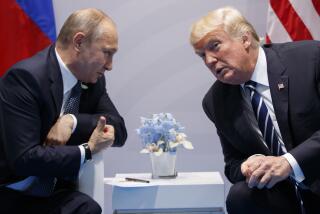Russia is back
- Share via
FLUSH WITH PETRO dollars, Russia is again a star on the world stage. Russians have more geopolitical clout than they’ve had for 30 years. Moscow’s new confidence -- perhaps overconfidence -- is based on high commodity prices and seven years of strong economic growth. Now the Kremlin is flexing its muscles toward the Middle East, China and Europe.
But the West doesn’t yet get that Russia is back. Many U.S. and European leaders continue to see Russia as a diminished power that can protest, but not obstruct, while the West binds Moscow’s neighbors to NATO.
At the G-8 summit that begins Saturday, hosted by Russian President Vladimir V. Putin in a newly renovated St. Petersburg, Washington should spend more time studying the trade statistics and less time focusing on Putin’s shortcomings. It needs to recognize that this Kremlin will vigorously pursue Russia’s national interests and will try to compete with the West for political and economic advantage.
Like it or not, there’s a new nonaligned power at the table.
The cornerstone of Putin’s strategy is resource nationalism, an expansion of state control over extractive industries that underlies Russia’s economic power and rising role in world affairs. State-owned oil firms control more than 30% of Russian production; rumored buyouts of now private oil firms could raise that percentage to 60% by 2008. Early this year, the Kremlin took direct control of Gazprom, which produces 20% of the world’s gas and possesses 16% of total reserves. And the Kremlin has effectively used taxation and licensing policy to increase its sway over oil policy.
The sharp rise in metals prices over the last five years has contributed to Russia’s economic might. Russia is among the top five producers of nickel, titanium, aluminum, platinum and palladium, vital to aerospace, automotive and other key global industries. VSMPO-Avisma, which produces one-third of all titanium, and Norilsk Nickel, which generates one-fifth of all nickel, are likely targets for state control.
Russia’s economy is surging, averaging 6.1% GDP growth since 2001. The retail sector has averaged 12% growth, construction is up 10% and services 7%. Although income disparities remain great, urban Russians in particular are enjoying higher living standards -- and not just because of oil wealth.
Finally, Russia’s exemplary macroeconomic policy has kept a lid on inflation while the relative stability of Putin’s presidency has facilitated growth.
But is Russian economic power -- and growth -- sustainable? Probably. Energy and metals prices are likely to remain robust for the foreseeable future because of tight market conditions and instability in producer countries such as Iran and Nigeria. Despite recent corrections, metals prices are expected to remain high because of strong demand. And Russia’s political system shows few signs of instability.
Admittedly, Russian power does face challenges. In the long term, lack of systemic reform threatens growth and stability; little progress has occurred on restructuring monopolies, administrative reform or stemming corruption. Investment in new oil and gas fields is sorely needed, as production rates have dropped. Unless reforms are implemented, GDP growth could fall and with it public support for the government. Politically, Putin is very strong, and he probably will anoint a successor with ease. But to remain stable, Russia needs a robust institution of the presidency, with the power to govern and referee economic issues, not just a strong individual like Putin as president.
Despite these problems, high commodity prices, growth and political stability probably will ensure that the Russian economy continues to strengthen through at least 2012.
Moscow’s reemergence in international affairs is manifest on many fronts. It is playing a pivotal and independent role in the Iran nuclear crisis, confidently resisting the U.S. push for sanctions and pursuing its own multiple interests in Iran. The Kremlin broke ranks with the West and held talks with Hamas. Russia is drawing increasingly close to China, to whom it will become a significant supplier of oil and gas within the next decade. And, last year, the two nations held large joint military exercises.
But Russia is also overreaching. Moscow shook European capitals in April by saying it would seek other customers unless it is allowed to purchase gas distribution assets in Europe. But Putin was bluffing; the infrastructure needed for Russia to take its gas elsewhere won’t exist for a decade. Meanwhile, Russia is actively backing illiberal governments in its neighborhood, including Uzbekistan, Kazakhstan and Belarus, policies that are troubling for U.S. interests and values.
Washington needs a better strategy. As it prepares for the G-8 summit, the U.S. should adopt a new paradigm for relations with Russia: “managed competition.” The U.S. should view Russia as it does China or India -- respecting Moscow as a major, nonaligned power. The days of Russia as a “junior partner” are gone. Washington should recognize that all great powers have special influence in their neighborhoods, yet quietly and frankly discuss differences over Eurasia and democracy.
This policy would improve relations with Russia’s petro-proud leaders and lead to more cooperation on nonproliferation, the war on terror, energy, the environment and a host of other issues. Washington needs to move forward based on the reality of the new Russia.
More to Read
Inside the business of entertainment
The Wide Shot brings you news, analysis and insights on everything from streaming wars to production — and what it all means for the future.
You may occasionally receive promotional content from the Los Angeles Times.









